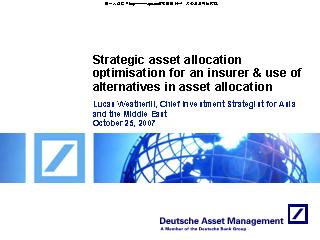
Strategic asset allocation optimisation for an insurer & use of alternatives in asset
allocation
Lucas Weatherill, Chief Investment Strategist for Asia and the Middle East
October 25, 2007
The idea of a Balanced Portfolio is confusing
50% Equities and 50% Bonds…
…does not mean half the return comes from each…
…and nothing like half the risk
What drives the diversification benefit?
Correlation between US Equities and US Bonds
Markets do not provide the same upside as downside…
…so we can’t model them as Normal
The Breadth of Alternatives is huge
The Problem with “Diversification”
Do you actually get any benefits when you need them?
August 1998
Global Equities fell 14%
What performance did we see from Diversifying assets?
CSFB Tremont Hedge Fund index -7.9%
Global REITs -11.2%
Gold -4.8%
US High Yield -5.2%
CRB Commodities -6.3%
US Bonds +1.6% - The only positive returning asset class
The Problem with “Diversification”
Do you actually get any benefits when you need them?
September 2001
Global Equities fell 9%
What performance did we see from Diversifying assets?
CSFB Tremont Hedge Fund index -0.8%
Global REITs -11.0%
Gold +7.1% - The best returning asset class
US High Yield -7.2%
CRB Commodities -8.8%
US Bonds +1.2%
The Problem with “Diversification”
Do you actually get any benefits when you need them?
July - August 2007
Global Equities fell 2%
What performance did we see from Diversifying assets?
CSFB Tremont Hedge Fund index -1.5%
Global REITs -2.4%
Gold +3.4% - Again the best performing asset class
US High Yield -2.1%
CRB Commodities -2.4%
US Bonds +2.1%
Strategic Asset Allocation – Assets and Liabilities
The process forces an understanding of the problems
Optimise alpha and beta exposure
Determine Client
Requirements
Tactically adjust portfolio mix
Monitor and Control
Set Assumptions
5-7 year horizon
Expected Returns and Risk
Correlation
Risk Tolerance
Return Requirements
Constraints
Monte Carlo based optimisation process
Genetic Algorithm engine
Alpha and beta separation
12-18 month time horizon
Value based process
Strong focus on risk management
Daily portfolio monitoring
Regular external (compliance team) supervision
Assumptions are Everything
Asian Equities expected return of about 7.5% per annum (in USD)
The sustainable dividend yield is roughly 3%
GDP per capita growth of about 2-3% is an upper bound for real earnings growth
Inflation will remain in the 1-2% band
A slight re-rating to see Asia trade at developed market multiples
Global Equities expected return of about 5-6% per annum (in USD)
(15页).jpg)
一、选择题(每题3分,共15分) 得分评卷人 1. 设事件 与 同时发生必导致事件 发生,则下列结论正确的是( B ). A. B. C. D. 2.假设连续型随机变量X 的分布函数为 ,密度函数为 .若X与-X有相同的分布函数,则下列各式中正确的是( C ). A. ...
已下载:2次 是否免费:否 上传时间:2018-08-06.jpg)
一.填空题(每题4分) 1.已知 , ,,则 , . 2.设一次实验中成功的概率为 ,进行25次重复独立试验,当 时,成功次数的标准差的值最大,其最大值为 . 3.设随机变量 和 相互独立,且服从 , ,则 的分布律为 ...
已下载:0次 是否免费:否 上传时间:2018-08-05.jpg)
一、(本题满分24,每小题4分)单项选择题(请把所选答案填在答题卡指定位置上): 【 】1.已知 与 相互独立,且 , .则下列命题不正确的是 【 】2.已知随机变量 的分布律为 则 等于 【 】3.设随机变量 与 均服从正态分布 , ,而 ,则 对任何实数 ,都有 . 对任何...
已下载:0次 是否免费:否 上传时间:2018-08-04.jpg)
一.填空题 1.设 为三事件, 则这三个事件中至少有一个发生可表示为______________. 2.口袋中有5个白球,3个黑球,从中随机地取出2个球,则取得2个球颜色相同的概率是__________. 3.设事件 相互独立, ,则 =__________. 4. 已知10个产品中有1个次品,现...
已下载:0次 是否免费:否 上传时间:2018-07-19(27页).jpg)
(以下1-50 为单项选择题,每题 1分,共50分;每题选对的给分,选错或不选的不给分) 1. 会计是使经济责任得以落实的手段,是一种管理活动。会计的这一层涵义主要考虑的是( ) 。 (A) 会计活动的结果 (B) 会计活动的手段 (C) 会计的计量技术 (D) 会计...
已下载:0次 是否免费:否 上传时间:2017-12-29.jpg)
概论 论述风险与保险的基本关系(考试论述) 寿险与非寿险的关系(统一用A4纸答号,随试卷上交500字以上) 一、非寿险和非寿险精算 非寿险是与寿险相对而言的,是指寿险以外的其它保险业务,主要包括财产保险、责任保险、健康保险和意外伤害保险等。 (一)财产保险 财产保险是以有形的物质财富及相关利益为保...
已下载:0次 是否免费:否 上传时间:2017-09-09Copyright © 2009-2022 深圳市圈中人电子商务有限公司 粤ICP备05047908号
您是否真的需要安全退出?
确认退出